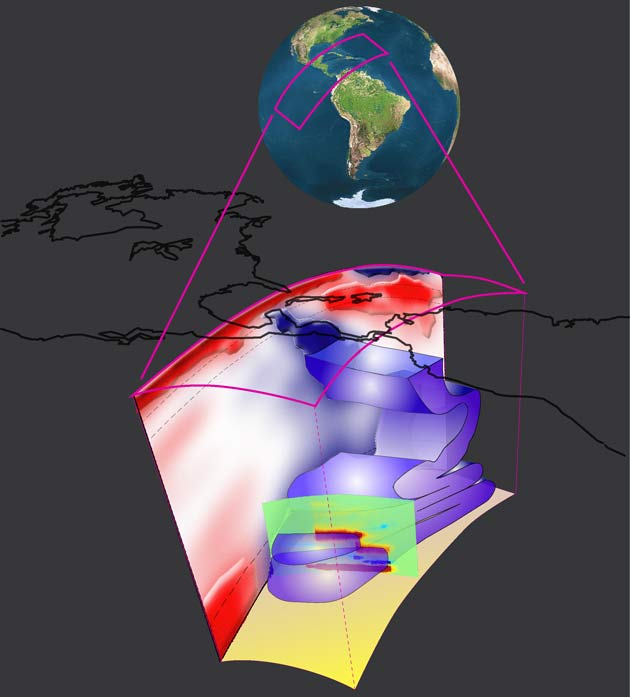Giant Slab of Earth's Crust Found Near Core

A huge slab of folded Earth that scientists think used to be part of the ocean floor has been detected near the planet's core.
The discovery supports the theory that Earth's crust is constantly recycled deep into the planet as molten material from below simultaneously pushes up to refresh the surface.
The structure is about 125 miles deep and at least 125 miles wide and 370 miles in the north-south direction. In consistency, it is more like a giant, folding mush of taffy, researchers said today.
"If you imagine cold honey pouring onto a plate, you would see ripples and folds as it piles up and spreads out, and that's what we think we are seeing at the base of the mantle," said Alex Hutko, a graduate student University of California, Santa Cruz and lead author of a paper describing the discovery in the May 18 issue of the journal Nature.
Giant recycling machine
The slab began its plunge toward the center of the Earth about 50 million years ago. It is denser than surrounding material, which is why it sinks. Its lower reaches are near the core, about 1,740 miles down. Yet it is still attached to the surface, much like a conveyor belt.
"It's like a carpet sliding off the dining room table," said study team member Edward Garnero of Arizona State University. "If it is more than half way off, it just goes taking everything with it."
Get the world’s most fascinating discoveries delivered straight to your inbox.
Earth is divided into three main layers: the core, mantle and crust. The crust, a thin surface layer, is divided into more than a dozen major plates. In the middle of the Pacific Ocean, plates spread apart and fresh material from the mantle wells up.
Along the west coast of North America, crust beneath the ocean dives under a continental plate, creating earthquakes and volcanoes. Geologists have long speculated that when crust is folded into the planet, it sinks to the bottom of the mantle, where it displaces the material down there and forces some of it up.
"Since there is a conservation of mass in the mantle, something must return as the slab sinks into the Earth," Garnero explained. "This return flow can include plumes of hot material that gives rise to volcanism."
Seeing sound
If the scientists have correctly interpreted their data, the folding slab is the first hard evidence that sinking crust drives the upwelling of material so deep inside the planet.
"It's the first evidence from direct imaging to support the idea that ancient seafloor makes its way down to the bottom of the mantle," Hutko said.
The slab was found by monitoring seismic waves—generated by earthquakes in South America—reflecting from deep inside the mantle and recorded in the United States.
The diving crust is made of essentially the same material as the lower mantle, the researchers said, but it is much cooler, by about 1,260 degrees Fahrenheit. The lower mantle is roughly 4,500 degrees.
Seismic waves are altered as they move through the hot and cooler regions, which allowed computer programs to generate the picture of the slab. It is possible, Garnero told LiveScience, that they are just seeing a formation of rock from the mantle that has different chemical components, but the temperature difference is best explained by crustal material that has been compressed, he said.
The sound-imaging technique also revealed plumes of hot material at the lower edges of the slab.
"We think there is a kind of pushing and bulldozing away of a hot basal layer of the mantle, giving rise to small plumes at the edges," Hutko said.
- Top 10 Ways to Destroy Earth
- Hole Drilled to Bottom of Earth's Crust
- Breakthrough: New Way to Peek Inside Earth
- Earth's Core Rotates Faster than Surface, Study Confirms
- Mystery Vibrations Detected Inside Earth
- GALLERY: Volcanoes
The crust thickness averages about 18 miles (30 kilometers) under the continents, but is only about 3 miles (5 kilometers) under the oceans. It is light and brittle and can break. In fact it's fractured into more than a dozen major plates and several minor ones. It is where most earthquakes originate.
The mantle is more flexible – it flows instead of fractures. It extends down to about 1,800 miles (2,900 kilometers) below the surface.
The core consists of a solid inner core and a fluid outer core. The fluid contains iron, which, as it moves, generates the Earth’s magnetic field. The crust and upper mantle form the lithosphere, which is broken up into several plates that float on top of the hot molten mantle below.
SOURCE: LiveScience reporting
Robert is an independent health and science journalist and writer based in Phoenix, Arizona. He is a former editor-in-chief of Live Science with over 20 years of experience as a reporter and editor. He has worked on websites such as Space.com and Tom's Guide, and is a contributor on Medium, covering how we age and how to optimize the mind and body through time. He has a journalism degree from Humboldt State University in California.




